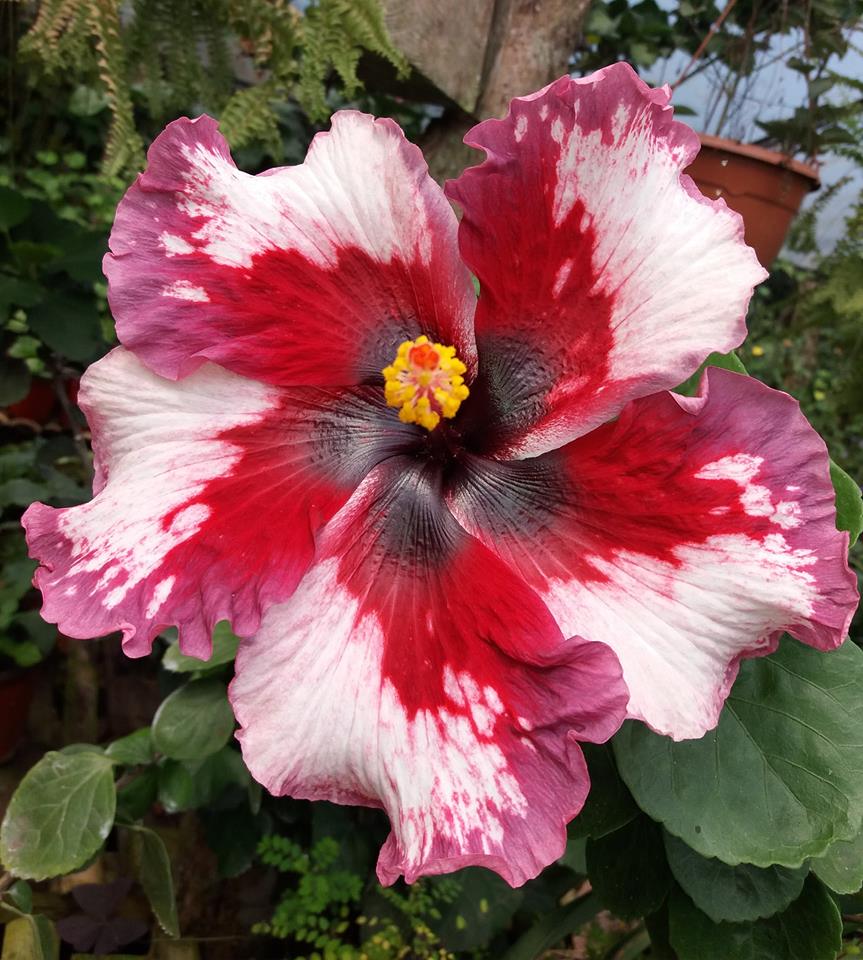Care & Growing
Growing exotic hibiscus is not an easy task and takes several years to master. There is a learning curve that spans multiple growing seasons.
Know These Core Elements Before You Do Anything
1. The Golden Rule of Growing Hibiscus
What you see now on your hibiscus plant was caused by inputs 2-3 weeks ago. This is a game changer when it comes to diagnosing your plant’s current status. Please read up on this in detail on our dedicated webpage for this important concept: The Golden Rule of Growing Hibiscus
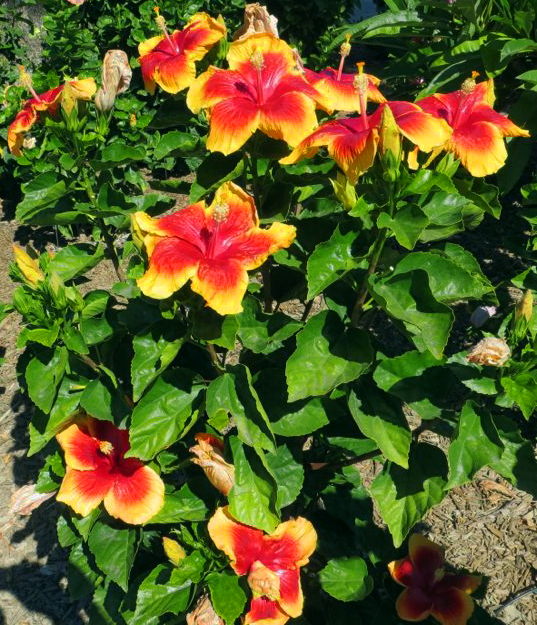
2. Hibiscus need soil with lots of air in it all the time
Hibiscus roots are tender and fragile and are very susceptible to root rot. The soil and pot you choose to grow your hibiscus in is critical. The soil needs to be light and fluffy with lots of air in it. Choose a potting soil that has lots of perlite and/or pumice in it. Avoid soil mixes that have worm castings and composted materials in them best you can as those components lose all air when wet and become very heavy. Those components quickly create the conditions you want to avoid when it comes to growing hibiscus successfully. Make sure the pot you use has many drainage holes and check periodically to see if the roots of your hibiscus have grown into those drainage holes and have plugged them up. Do not pack the soil down tightly as that will remove all those needed small air pockets. Just tamp down lightly and gently probe your fingers down to make sure the soil is all around the roots and you don’t leave any open spaces. Also do not place a layer of rocks in the bottom of your pot – that actually blocks all drainage and creates a water damn inside your pot. Same thing as a French Drain.


3. Hibiscus Need Lots of Fertilizer But Not the Typical Types
Hibiscus are some of the most hungriest plants you will come across so feeding them is an important part of their good health and ability to grow and bloom. Hibiscus need very high amounts of potassium, very low amounts of phosphorus and med to low nitrogen. The hotter your climate the less nitrogen they need. Almost all plant and flowering plant fertilizers have similar NPK ratios which are the opposite of what hibiscus need. Unfortunately phosphorus is usually the most popular ingredient in most fertilizers as it is cheap and helps boost the profit margin of the product. Same with nitrogen. Potassium is much more expensive so you do not see it in high amounts typically in fertilizers.
We recommend Hidden Valley Hibiscus Special Blend Fertilizer as it has been formulated through years of field testing to have the perfect balance of nutrients a hibiscus plant needs. If you do not have access to ordering it or live outside the United States a good substitute is Palm Tree Fertilizer which is similar in composition.
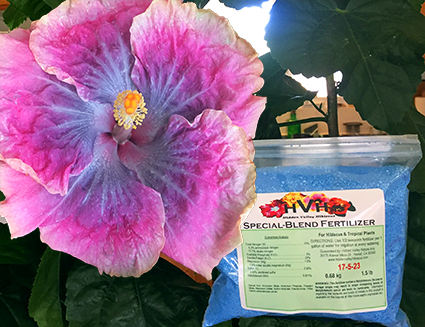
Hidden Valley Hibiscus Fertilizer/fertilizer.htm
4. Before Watering Your Hibiscus Always Check Two Things First
The most common way to kill your hibiscus plant is to overwater it. Those tender roots very quickly encounter problems once there is not enough air in the soil. This sounds easy but it is not as hibiscus do everything different than most plants and that includes how they show they are in trouble. If you are using a correct fertilizer then you should feed your hibiscus every time you water it. But before you water it you have to make sure if it needs it and how much. If you have your hibiscus plant in a small pot then chances are it will dry out quickly and it will require watering frequently but for medium size pots and larger it requires a much different approach.
The two things you should always do before watering is check the top growth and leaves of your branches and have a water meter on you to check the water content deep down. If you see pale and veiny leaves that is a sign that the roots are not getting enough air. Many growers especially those experienced with growing other types of plants see the pale and veiny top growth and assume the plant has a nutrient deficiency like iron or magnesium. So they water the plant with those supplements to correct the problem not realizing they just did the worst thing possible – adding more water when your hibiscus needs a break from it. Also you will be amazed at how long that state can last depending on the soil you used and what type of heat your plant gets. You can go for months without watering a hibiscus plant and it will be fine. In winter this is common not to water for months. Surprisingly we see the most root rot problems in late summer and fall after growers have overwatered their hibiscus due to heatwaves after seeing that top soil layer looking bone dry without checking the soil deep down.
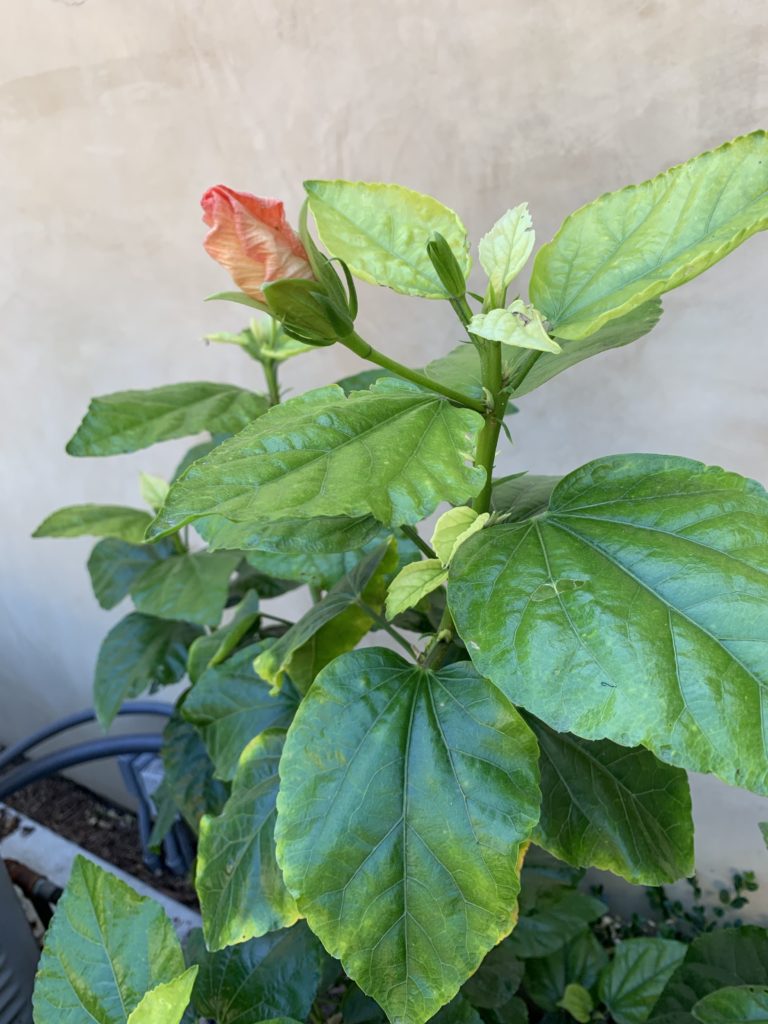
Even if you don’t see pale and veiny growth you should still use a water meter to check what the soil deep down by the roots is like. During hot weather and summer this is very important as the top layer of soil will dry out completely but deeper down the soil can be saturated. Slowly probe your water meter down and watch carefully to see if it starts to go from dry to very wet the deeper you get. If this is the case then just give a splash of water to get that top layer rehydrated. Again always feed your plants when you water with the correct type of fertilizer and if you are experiencing a heatwave of temperatures over 95F then you need to start reducing the amount of fertilizer you use due to your plant’s increased rate of metabolism.
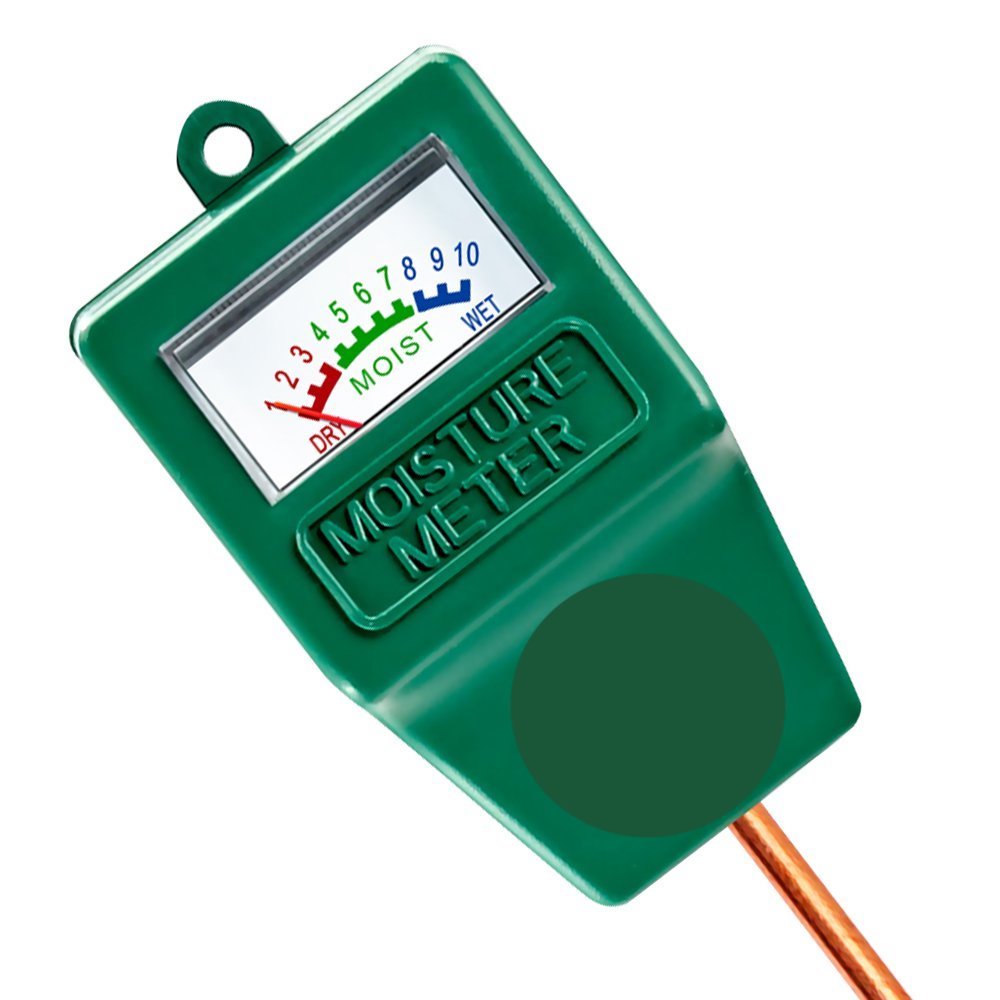
5. Hibiscus Not Used to Direct Sunlight Above 95F
Being hibiscus are from tropical origins they are designed for steady temperatures and weather. The tropics rarely get above 95F and the weather is not seasonal. Most of us growing hibiscus are doing so in regions of the world that are not tropical and the weather changes with the seasons. Hibiscus do best with the same constant inputs and have a narrow range of needed temperatures of 65F – 93F. When it comes to very hot temperatures hibiscus can handle it successfully only if they are given a month or two to gradually adjust. Unfortunately many times we get heat waves and the temperatures can jump 15-20 degrees in just a few days. Worst case scenario here in So Cal is to have a heat wave in late June or early July after a couple of months of overcast (June Gloom) weather. That is a huge shock to a hibiscus and the results will be rather ugly. If exposed to direct sunlight of over 95F your plant will become stressed as it is not used to such strong heat and start to shed leaves and drop buds. The photo below is a perfect example of the reaction a hibiscus will have a week or so after a sudden heatwave. The good news is the new leaves it will produce will be even more heat tolerant than the ones that yellowed and fell off. The bad news is your hibiscus plant is a very efficient organism and it realizes with such hot temperatures it doesn’t need nearly as many leaves so it will not replace many of the lower and middle leaves. This might leave your bush looking rather leggy with mostly leaves on the top third of the plant. Again the moral of the story when growing exotic hibiscus outdoors is you are at the mercy of the weather.
Also when temperatures rise over 95F your hibiscus plant’s metabolic rate will start to really speed up. This means it will take up water more quickly and any fertilizer that is in it. So you will need to cut back on the amount of fertilizer by 25% for every 5 degrees increase in temperature. Once temps are 105F or more you should only use water at that point.
Finally whenever temps get over 90F spider mite reproductive cycles start to speed up significantly. Their typical reproductive cycle is about 2 weeks when temps are in the 80s or cooler. Once above 90F they will reproduce at a faster rate until they get that cycle down to 2 days when temps are over 100F. Yes two days! That is how you have an exponential population explosion and they can ravage your plants in a matter of a couple weeks when they get going under these conditions. Please see our webpage about spider mites for more info: Spider Mites
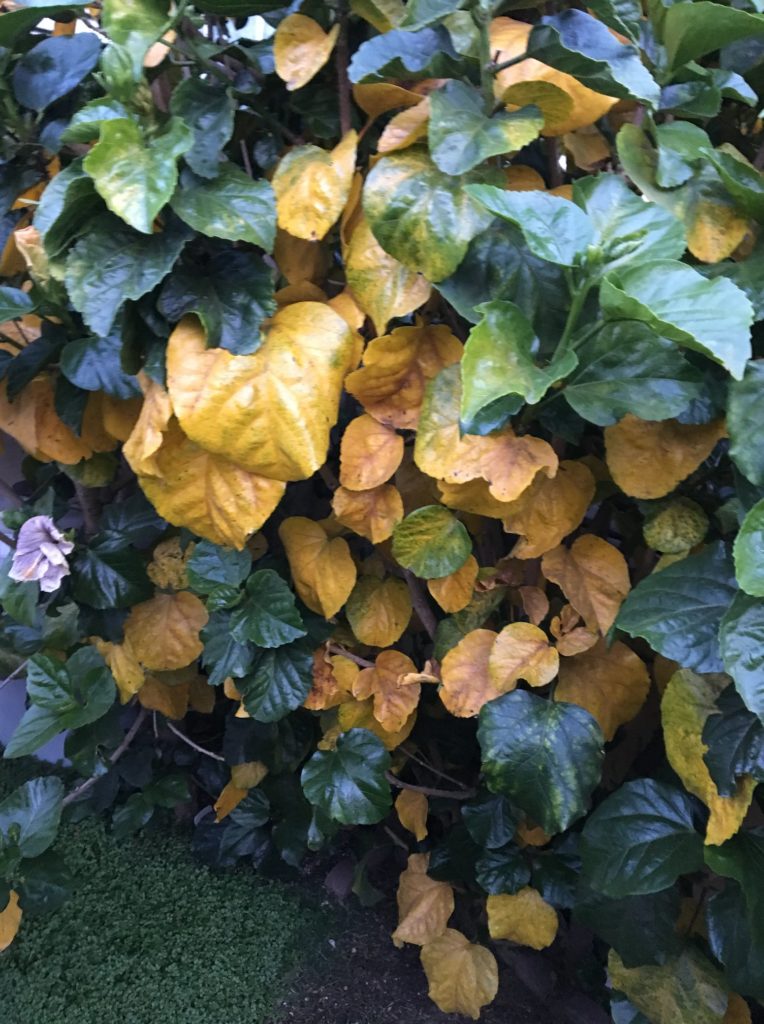
6. Hibiscus Hate Change
Being hibiscus originate from tropical regions they are genetically geared for consistent temperature and weather climates. Seasons and dramatic variations in weather are inputs they are not suited for and they can easily affect them in negative ways. When you move your plant for the season from outside to inside this can be very stressful to your hibiscus. Anytime you move your plant to a new location you have to think about how to do this in a gradual way. Acclimation over 2-3 weeks is a the way to let your hibiscus adjust so it doesn’t go into any shock. This even applies to changes in the amount of water and fertilizer you give them. Those tender root systems can be quickly upset and your plant will be in trouble before you know it.
If you do move your plant indoors during colder months one of the biggest challenges isn’t just providing it with enough heat but also humidity. Inside a residence that is heated during winter means the air is very dry and that is one of the biggest enemies facing a hibiscus plant that originates from tropical, humid climates. Check out our propagation page for seed germination to get an idea of the ideal conditions and things you can do to make your hibiscus flourish indoors: Seed Germination in So Cal
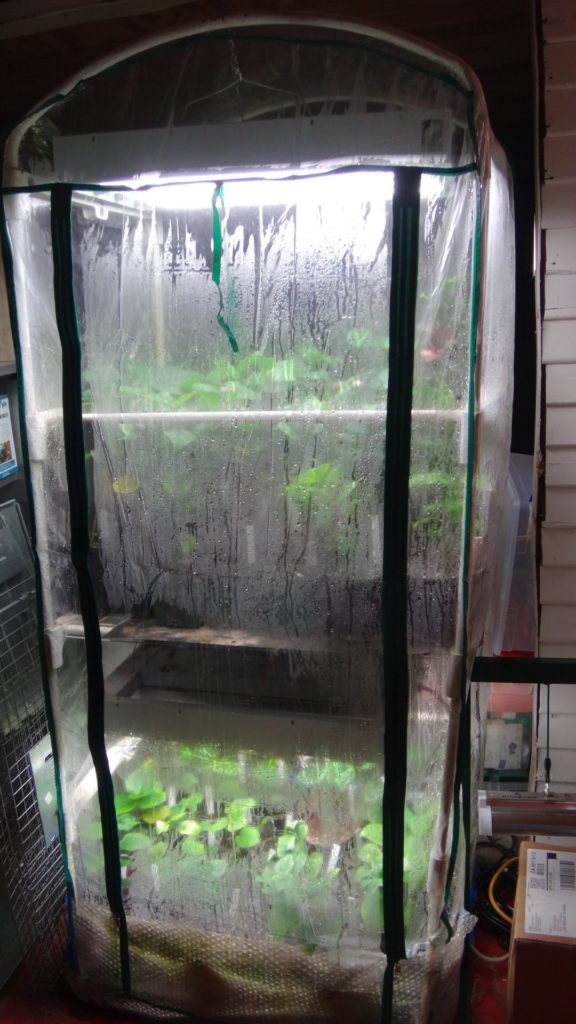
7. Every Location Has It’s Unique Growing Requirements
One of the biggest problems we run into is bad advice. And interestingly it most often comes from the most experienced plant growers who are great at growing other types of plants. The problem is they assume that hibiscus are like other flowering plants and have the same requirements. We wish this was the case but it is not and can lead to disastrous outcomes for your hibiscus. You need to be a plant detective when it comes to growing hibiscus and learn to be patient and a keen observer. This is the most important advice we can give.
- BE PATIENT – DO NOT TAKE ACTION IMMEDIATELY UNLESS YOUR PLANT IS DEHYDRDATED
- KEEN OBSERAVATIONS ARE KEY – HIBISCUS SHOW SUBTLE SIGNS THAT THEY ARE IN TROUBLE SO YOU HAVE TO PUT THE CLUES TOGETHER FOR PROPER DIAGNOSIS
Along these lines it is also a crucial factor that for each location of growing hibiscus even if both are in Southern California for example there are many factors that will call for different inputs and techniques to get optimal results. This is even true from one side of your yard to the other. Sun angles, shade and evaporation can vary a lot and will require different inputs. An example is a yard with walls around it. During winter months when the sun angle is low the plants on the south side of a property will find themselves in heavy shade during those cool months so very little water and a soil mix with heavy amounts of perlite or pumice will be needed to keep the soil aerated especially with rain events. Plants on the other side of your yard will get heavy sunlight year round so during winter they are fine but in summer they will need higher amounts of water and the direct sunlight during the hot months might be too high for them. A soil mix lower in perlite or pumice might be better for water retention as well as some sort of ground cover like wood chips to further reduce evaporation.
These are the kind of things a dedicated hibiscus grower will need to analyze and tinker with over multiple growing seasons to figure out what works best for their particular set up. We try our best here to give you all the parameters and proven information for you to start applying to your hibiscus. Read and reread what we have here, then ask those you know who are successful at growing hibiscus and then take what you hear and apply it. Some things you will have to alter or cease applying as you see what works and doesn’t. In the end you really do become a detective that has to piece together the right combination of inputs.
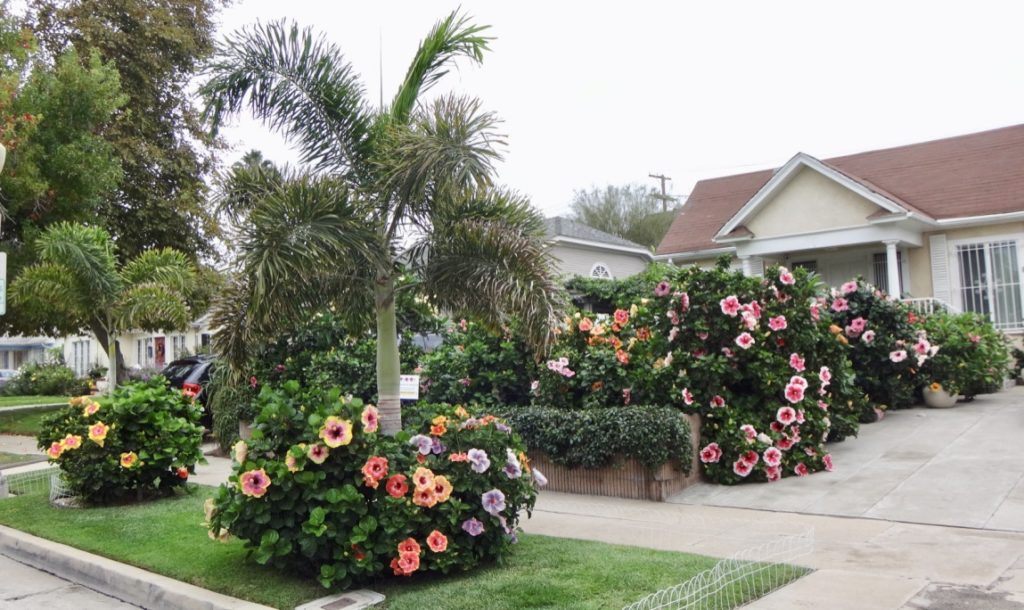
8. Growing Exotic Hibiscus Takes Much Time and Dedication
Exotic hibiscus are without doubt with their incredible blooms exceptional and captivating. But they are not easy to grow and take a lot of your time and dedication to come down a learning curve that is full of ups and downs. We see many people that at first are incredibly moved and excited to grow them but after trying for a year or two they give up. It takes long term dedication and patience to become a successful grower. So be prepared beforehand to commit to giving them the proper time and attention needed. These are very needy plants that require constant care and monitoring. The rewards are amazing but the road to get there can be a tough one.
Be prepared for a roller coaster of ups and down. Some of the best advice we can give is that from your biggest failures you will make your greatest advances. Even the best of us have killed many many hibiscus plants but we don’t let that stop us and we learn that if we can advance our growing skills from these setbacks then the road ahead is better. You will be at the mercy of the weather, pests and sometimes life in general as other priorities might supersede your time to properly take care of your plants. Hang in there and know that you are not alone – we are here to help. And in the end great things await those that persevere.
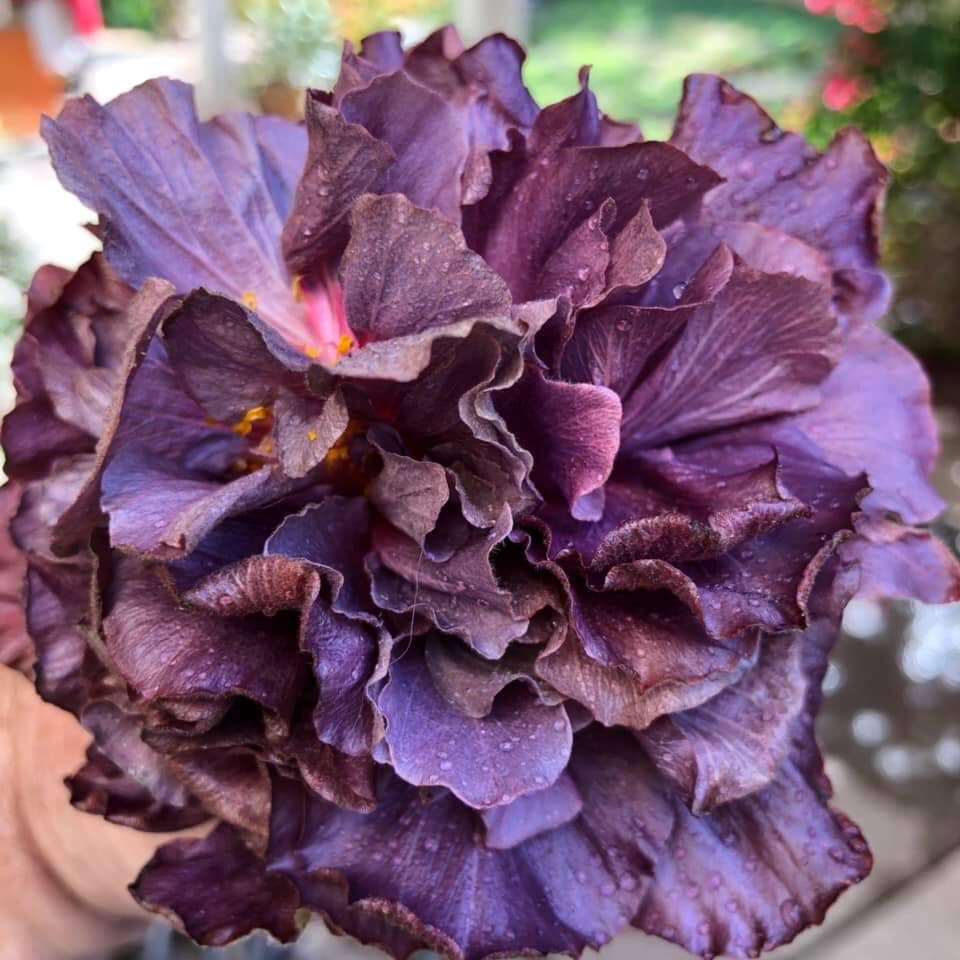
Hibiscus originate from tropical climates so they do not like seasons and large temperature swings

Hibiscus History at Hidden Valley Hibiscus
Soil & Feeding
- Being that hibiscus originate in tropical climates for many millennia they are genetically programmed for the unique conditions of such regions.
- These are volcanic areas where the soil is rocky and extremely porous. Such soils are very rich with minerals and abundant with air. Your soil needs to be the same – we recommend a light potting mix and add ample amounts of perlite and/or pumice stone
- Do not add composted materials and very little worm castings as these will lose all air when wet and deplete the soil of the needed air to sustain hibiscus root systems.
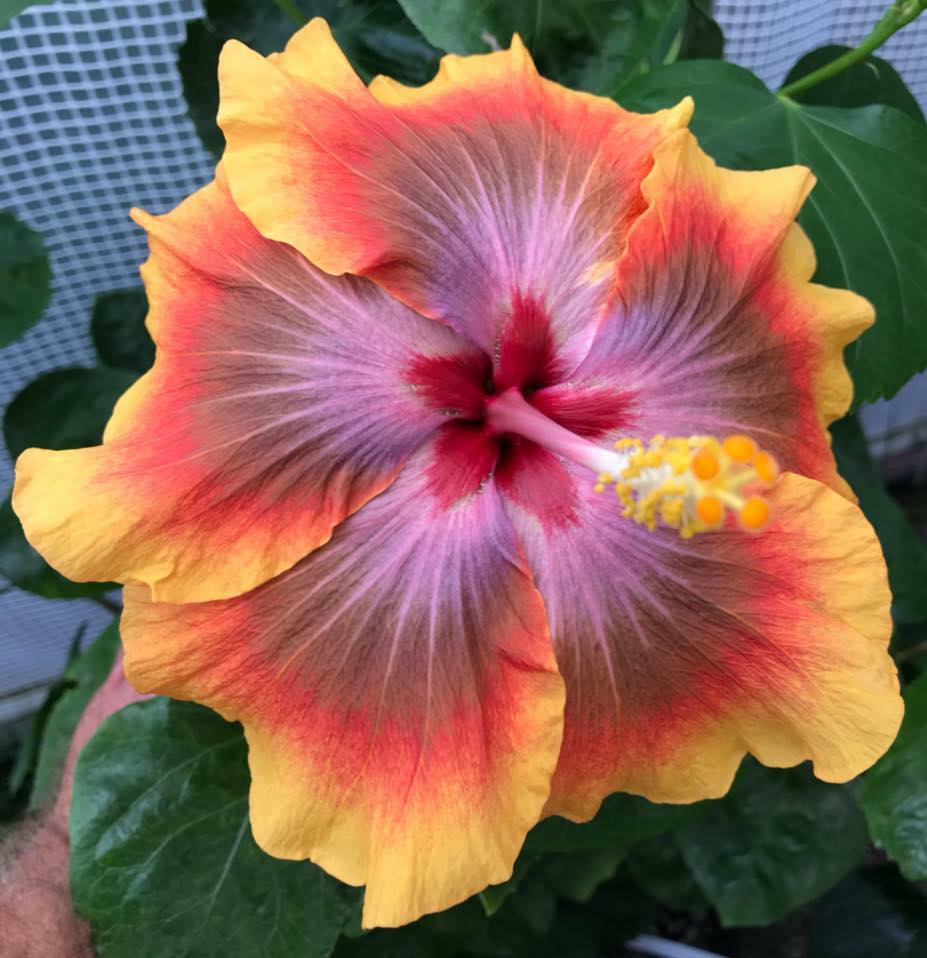
- Before you water or feed your hibiscus plant always first look at the top leaves of your plant’s branches. If they look veiny and/or chlorotic you need to first investigate your plant further to see if it is having issues at the root level. Those type of leaves indicate that there is not enough air in the soil which usually comes from too much water. Use a water meter to probe the soil, many times the top is bone dry but as you get deep down it is saturated. Any additional water can lead to root rot which you will see the effects when your plant has branch tip die back and leaves start to yellow and drop. For more info check out our webpage: Root Rot & Branch Tip Die Back
- Hibiscus roots are tender and need constant air so native soils like clay are a recipe for root rot and a quick demise of your plant. Make sure to dig as large of a hole as possible. We recommend at least 2-3 ft around and about 1 ft deep in ground.
- For potted plants make sure you use pots that have many drainage holes and do not layer the bottom of your pots with any type of rocks as they will actually form a seal. Also hibiscus roots can quickly plug up those drainage holes so you will need to root prune. We have a great video on how to do that: SCHS Root Pruning Video
- Volcanic soils are high in minerals so hibiscus are used to high amounts of nutrients all the time that are easy to get. They have unique requirements that differ from other flowering plants. Lots of potassium, very low phosphorus and low nitrogen. We recommend the fertilizer from Hidden Valley Hibiscus which is formulated just for hibiscus: Hidden Valley Hibiscus Fertilizer
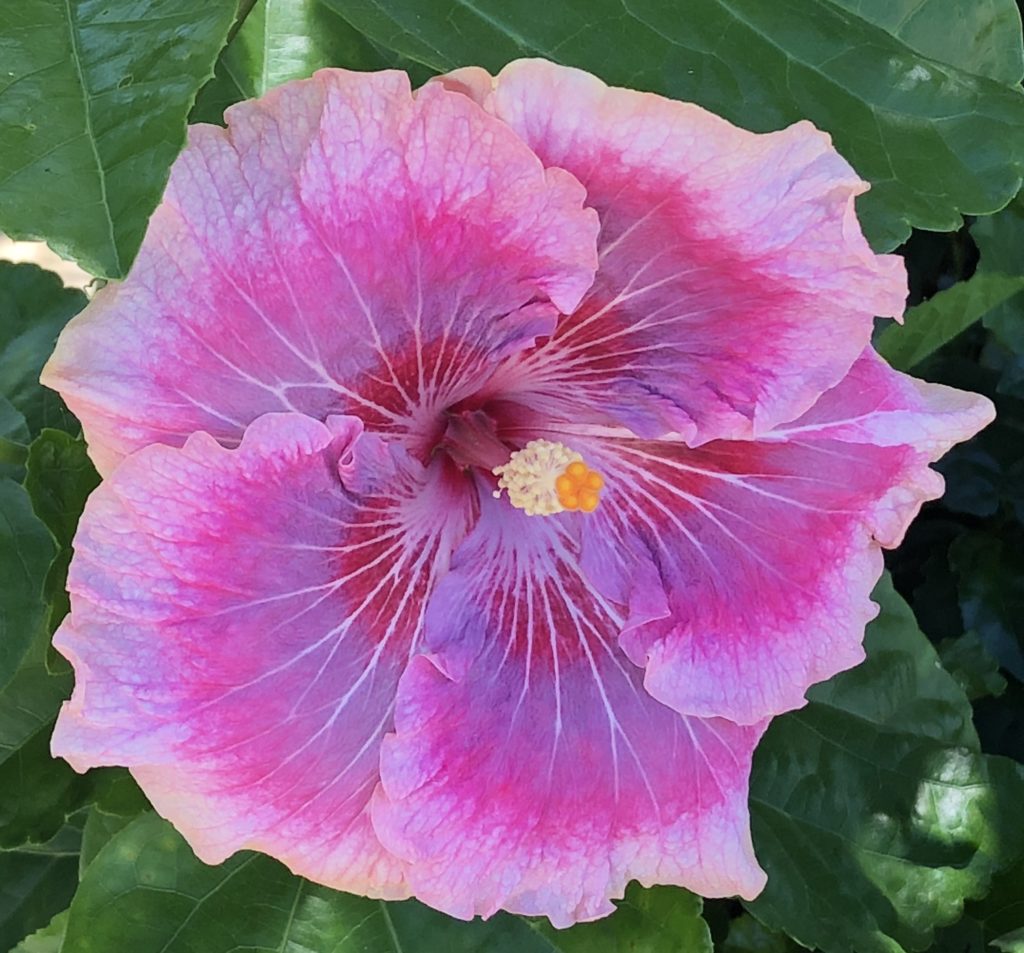
Temperatures, Metabolism and Sunlight
- Tropical climates do not have seasons so temperatures are normally 60-95F. Hibiscus thrive in these conditions and get stressed when living in extremes on either side of this spectrum
- Temps below this range will start to slow your plant’s metabolism. Here in So Cal we have observed when under 50F you will start to see a significant slowdown which show through monotone blooms that are smaller, reduced or no growth and the pads on your blooms might disappear.
- Reduce watering proportionately with the drop in temps. Your plant is not up taking as much water and if it rains that will start to remove the air from your soil which is worst case scenario for hibiscus.
- Also reduce fertilizer since less water is being absorbed it will build up in the soil and when your plant returns to normal metabolism this will lead to severe fertilizer burn which can even kill a plant.
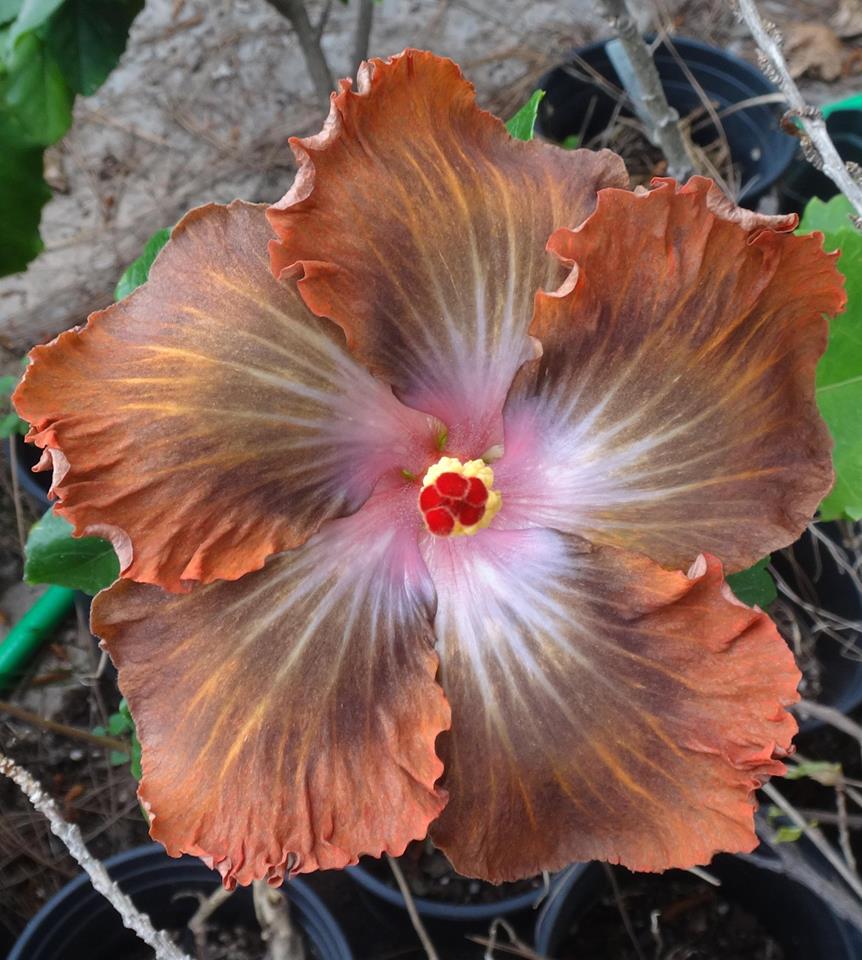
- Hibiscus leaves are not genetically developed to be in direct sunlight over 95F so that will start to stress your plant. You will notice yellow leaves appearing, buds dropping and smaller sized blooms.
- Your plant’s metabolism will continue to accelerate as the temps rise which means not only is it up taking more water but also more fertilizers. So it is important to also reduce the amount of fertilizer your plant is getting. We recommend for every 5 degrees you reduce the amount of ferts by 1/4. This is a good rule of thumb for both when it is hot or cold.
- If temps exceed 105F we recommend just water only
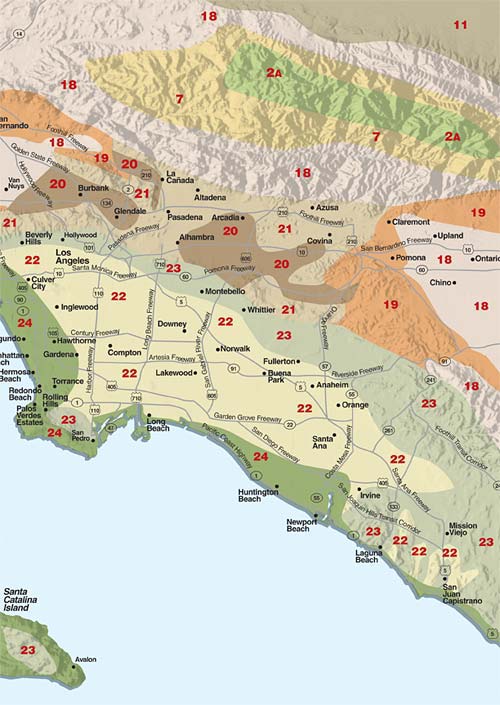
Care Essentials
- Always prune off (dead head) any spent blooms as your plant will waste valuable energy growing pods with non-viable seeds instead of producing new blooms
- Always keep the soil under and around your plant cleaned up and clear of fallen leaves and debris. This is important as your soil can become overly saturated when covered in debris and cannot evaporate water. Also pests like spider mites love dirty messy locations.
- Never spray your hibiscus with any products containing soap. Soap or detergent eats away the protective waxy coating of hibiscus leaves leaving them exposed and vulnerable to infections and pests.
- When spraying your hibiscus for any pests always add horticultural or neem oil as an effective sticking and drowning agent to the product you are using. This will increase your spraying effectiveness 30-40%
- Do not treat your hibiscus like your other landscaping plants. They have unique needs and require constant attention and will decline without it.
- Growing Exotic Hibiscus requires a time commitment so make sure you are ready to dedicate a portion of your time going forward.
- Hibiscus get stressed in direct sunlight over 95F so take action to give them shade in those temperatures.
- Do not plant more than one hibiscus in the same pot. They will compete for root space and one will eventually kill the others or all won’t survive at some point.
- Use a water meter and slowly probe down below the surface to see how wet the soil really is. During hot weather the top layer can dry out while the bottom of a pot is still completely saturated. Perfect recipe for root rot.
- Always disinfect all pots and tools used treating a diseased plant. Throw out all contaminated soil, never reuse or you will infect a new healthy plant.
Proper Growing Locations & Conditions
- Hibiscus need proper space and do not do well when competing with other plants including hibiscus for space and sunlight
- Hibiscus roots need space too – not only away from other plants but from tree roots that can come from far away, tangling up your hibiscus roots and crowding them out
- Never plant and grow hibiscus under pine trees
- Avoid from growing hibiscus under trees that heavily shade beneath them and/or drop leaves and other debris on a daily basis
- Walls and fences that soak up heat from the day are a good thing in cooler locations but can be much too intense in hot, sunny locations
- Most native soils are too clay like here in Southern California so dig holes at least 2-3 feet across and around 1 foot deep
- Hibiscus do not do well in Santa Ana winds so if you live in a wind prone area best to grow them where there is a wind break
- Be on the lookout for your gardeners interacting with your hibiscus. They do not understand they are special needs plants and will usually prune them and try to fertilize them in ways that are harmful for them
Southern California Hibiscus Growing by Region
- The Southern California Coastal Plain is the most ideal area for hibiscus to grow due to the strong marine air influence of the Pacific Ocean which acts as a moderator for temps.
- Coastal areas that see less sunlight and cooler temperatures should have hibiscus growing in maximum sunlight year round. Hibiscus thrive on heat to grow and create colorful blooms so shady areas are not going to work well for them near the coast.
- Inland Valleys are a challenge during the winter and summer as the temperature extremes can be significant. Also these areas are prone to Santa Ana wind events which are enemy #1 for hibiscus – cold and dry is the exact opposite of what they need. Winter hibiscus need full sun especially in the morning after a cold night. Summer they need dappled shade to protect them from direct sunlight over 95F
- Inland Empire and Desert areas are a challenging region to grow hibiscus. They cannot tolerate freezing temperatures plus the strong Santa Ana wind events during winter. The summer extreme heat is also too much for them to tolerate in direct sun. Growers of exotic hibiscus in these areas grow their plants in pots and move them indoors during winter and under shade in summer. Garden variety hibiscus are more hardy and if planted in less vulnerable areas might be able to make it year round but is a risky decision by the grower.
